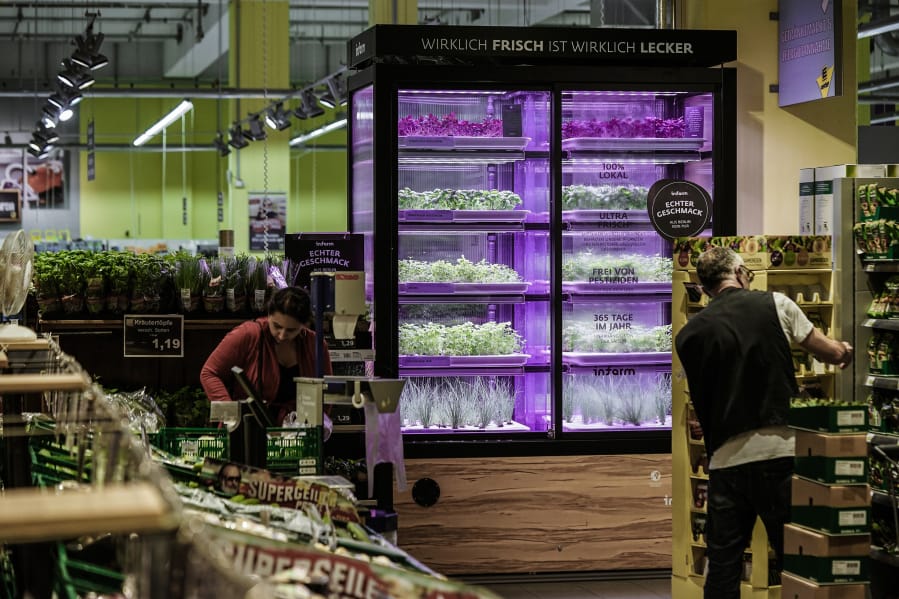QFC shoppers soon will be able to pick up their bunches of kale and parsley just inches away from where they grow.
The Seattle grocery chain’s parent company, Kroger, has partnered with German vertical-farming startup Infarm to hydroponically grow cilantro, kale and crystal lettuce right near the produce aisles of two Quality Food Centers in Kirkland and Bellevue. The first harvest of greens at those stores is due next week, and the company plans to expand to 15 QFCs in Washington and Oregon by April.
The two local stores are the first in the country to experiment with Infarm. Cincinnati-based Kroger, which operates nearly 2,500 grocery stores in 31 states under some two dozen brands, is testing the idea in the Pacific Northwest because “the market itself is fun and innovative,” said Kelli McGannon, Kroger’s QFC representative. “It’s also a place where residents want access to fresh, affordable produce and they’re concerned about the environment.”
Ever since Kroger rebranded in early November, changing its slogan to “Fresh for everyone,” the supermarket conglomerate has been making incremental changes to its local stores.
“How do we break out of that sea of sameness?” McGannon said. “We’re always trying to find ways to stay relevant.”
This is Infarm’s first partnership in the U.S., but it has hundreds of vertical, stackable farm units sprouting fresh greens in supermarkets and restaurants all over the world. The company uses a cloud-based platform to control lighting and temperature remotely, which it says enables the same type of produce to grow optimally no matter where it is.
Vertical-farming startups have struggled to grow while navigating a relatively new industry. San Francisco-based Plenty was expected to open a 100,000-square-foot vertical farm in Kent, but after two years of planning it announced last week the farm was too tall for the facility it leased in 2017. Some others, including Canada’s Local Garden Vancouver and Illinois-based FarmedHere, folded within a few years of breaking ground.
“There’s a lot more to growing vegetables than putting seeds in a pot,” said Persis Acworth, who manages the University of Washington’s 1.5-acre campus farm and other agriculture projects. “The biological activity of the Earth outside is difficult to replicate indoors.”
Infarm, like many vertical-farming companies, emphasizes the savings in money and energy that can be realized on transportation, water and chemical pesticides, while promising fresh and accessible food. Infarm says food plucked thousands of miles away loses nutrients and flavor in transportation.
Kroger said it expects to shave operation costs by using Infarm, and its produce only needs tending once or twice a week.
“I think if Kroger wants to do this, that’s great,” Acworth said. “[But] there’s a lot to be solved there, too.”
Vertical farming is still a high-maintenance venture. It’s best suited for low-maintenance and lightweight crops — “How would you vertically grow a pumpkin?” Acworth asked. Lack of crop diversity makes the plants more susceptible to pests, even in controlled indoor environments. Vertical farming also requires metropolitan real estate and specific energy and environmental conditions to operate efficiently, while outdoor farms can benefit from natural sunlight unhindered by tall buildings.
“Cost of real estate unifies the two of them,” Acworth said. Spaces for indoor farms and outdoor farms “are becoming prohibitively expensive.”
Infarm sells nearly 30 types of herbs and greens, but not a single piece of fruit. Meanwhile, Washington boasts a patchwork of 15 million acres of farmland across a variety of microclimates that have made it the No. 1 producer of hops, apples and asparagus.
“Vertical is much more interested in volume,” said Colleen Donovan, executive director of the Washington State Farmers Market Association. “The farmers we work with are generally operating on a much smaller scale.”
Small farmers, she said, “are very much committed to the local farmland, to enriching the natural resources, to working in sync with their own ecological areas.”
Kroger still sells its branded organic farm produce, since the Infarm-grown produce is technically not organic. The United States Department of Agriculture doesn’t have a process to certify plants grown using hydroponics, a practice that uses a nutrient solution mixed with water instead of soil.
McGannon said she expects the store-grown option to be popular with consumers. “They want a one-stop shop for their fresh produce,” she said. “It really is the closest access to fresh-grown produce as you can get.”



